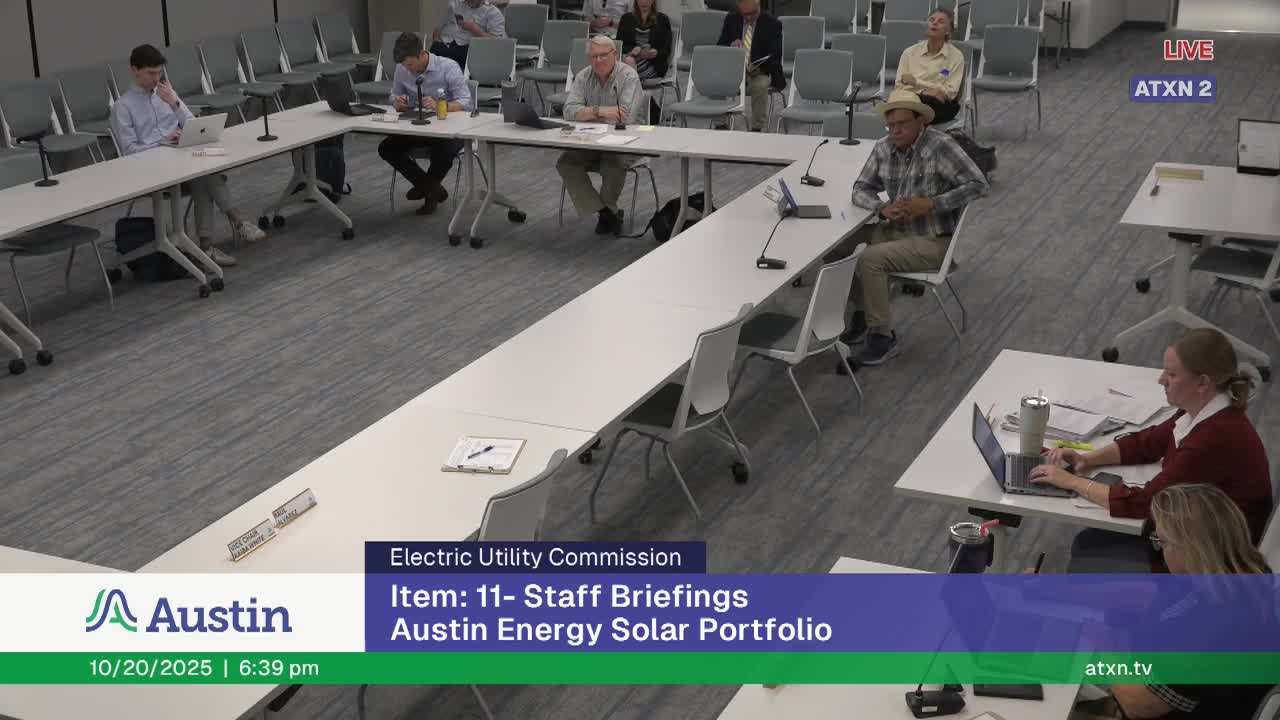Austin Energy reviews 28 years of solar work, 189 MW on distribution grid and new pilot plans
October 20, 2025 | Austin, Travis County, Texas
This article was created by AI summarizing key points discussed. AI makes mistakes, so for full details and context, please refer to the video of the full meeting. Please report any errors so we can fix them. Report an error »

Austin Energy delivered a historical review of its solar programs to the Electric Utility Commission on Oct. 20, reporting about 189 megawatts of solar connected to the distribution grid and a portfolio that includes community solar, residential and commercial installations.
Tim Harvey, director of customer renewable solutions, said Austin Energy has rebated more than 14,000 systems and counted roughly 16,500 systems online when customer‑owned and utility projects are combined. “Overall today, in the on the distribution grid, we have 189 megawatts of solar,” Harvey said, adding that the utility has invested more than $100,000,000 in incentives to support the local solar industry.
Harvey walked commissioners through program milestones: early rooftop utility projects and the Solar Pioneers and Solar Explorers community programs, the shift in 2012 to Austin’s “value of solar” buy‑all/sell‑all rate, later additions such as community solar at La Loma and Palmer Event Center, shared solar and a new commercial standard‑offer program introduced in 2025. He said residential install costs have fallen from about $8.25/W in the mid‑2000s to roughly $3.30/W today (DC).
On operational items, Harvey said Austin Energy performs 100% field inspections of solar interconnections to ensure safety and reliability. He said inspection turnarounds average around two weeks and the utility is staffing to handle an expected inspection surge tied to federal tax‑credit deadlines. Harvey also described an existing daily alert for customers and a monthly outreach process if a generation meter posts zero reads.
On new technology, he said meter collars and other new hardware must pass local evaluation before being added to the approved list; the utility has an in‑house review and pilot process that includes distribution and metering groups. Commissioners raised concerns about delayed inspections tied to new meter collars and about commercial permitting timelines; Harvey said distribution is conducting pilots and staff will review commercial permitting timelines.
Harvey also previewed planned pilots: a customer‑owned battery virtual power plant pilot planned for FY26 and continued development of shared solar and the commercial standard offer. He told the commission the utility expects to meet a 2027 local solar target (2205 MW was a figure cited for a different goal over time in the presentation) and said the program team will continue engagement with contractors and community partners.
The commission did not take formal action on the briefing. Staff said they would respond to specific follow‑up questions about inspection timing, approved meter‑collar specifications and the commercial permitting timeline.
Quotes are taken verbatim from the Oct. 20 meeting transcript and are attributed to speakers who appear on the record.
Tim Harvey, director of customer renewable solutions, said Austin Energy has rebated more than 14,000 systems and counted roughly 16,500 systems online when customer‑owned and utility projects are combined. “Overall today, in the on the distribution grid, we have 189 megawatts of solar,” Harvey said, adding that the utility has invested more than $100,000,000 in incentives to support the local solar industry.
Harvey walked commissioners through program milestones: early rooftop utility projects and the Solar Pioneers and Solar Explorers community programs, the shift in 2012 to Austin’s “value of solar” buy‑all/sell‑all rate, later additions such as community solar at La Loma and Palmer Event Center, shared solar and a new commercial standard‑offer program introduced in 2025. He said residential install costs have fallen from about $8.25/W in the mid‑2000s to roughly $3.30/W today (DC).
On operational items, Harvey said Austin Energy performs 100% field inspections of solar interconnections to ensure safety and reliability. He said inspection turnarounds average around two weeks and the utility is staffing to handle an expected inspection surge tied to federal tax‑credit deadlines. Harvey also described an existing daily alert for customers and a monthly outreach process if a generation meter posts zero reads.
On new technology, he said meter collars and other new hardware must pass local evaluation before being added to the approved list; the utility has an in‑house review and pilot process that includes distribution and metering groups. Commissioners raised concerns about delayed inspections tied to new meter collars and about commercial permitting timelines; Harvey said distribution is conducting pilots and staff will review commercial permitting timelines.
Harvey also previewed planned pilots: a customer‑owned battery virtual power plant pilot planned for FY26 and continued development of shared solar and the commercial standard offer. He told the commission the utility expects to meet a 2027 local solar target (2205 MW was a figure cited for a different goal over time in the presentation) and said the program team will continue engagement with contractors and community partners.
The commission did not take formal action on the briefing. Staff said they would respond to specific follow‑up questions about inspection timing, approved meter‑collar specifications and the commercial permitting timeline.
Quotes are taken verbatim from the Oct. 20 meeting transcript and are attributed to speakers who appear on the record.
View full meeting
This article is based on a recent meeting—watch the full video and explore the complete transcript for deeper insights into the discussion.
View full meeting
